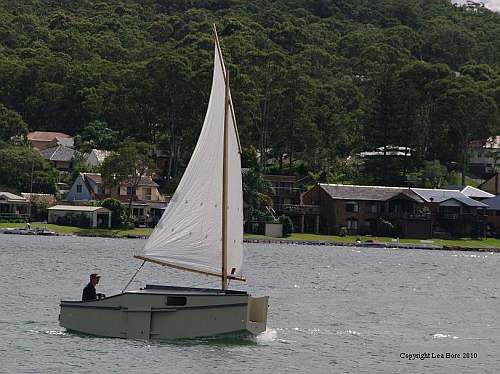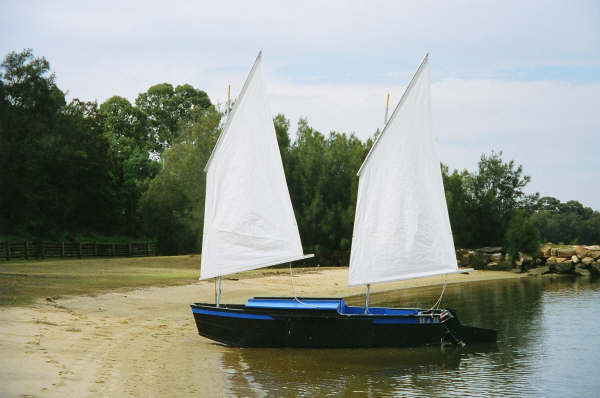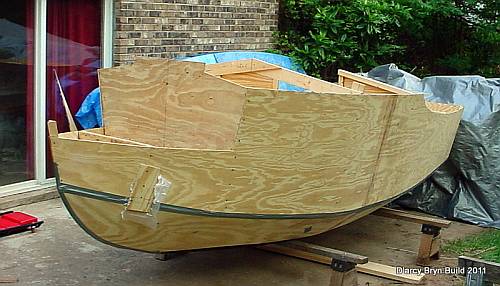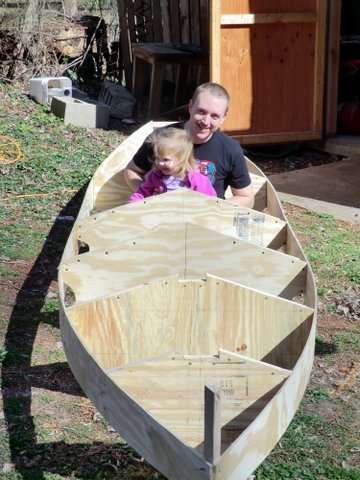Jim Michalak's Boat Designs
118 E Randall, Lebanon, IL 62254
A page of boat designs and essays.
(1May2012) This issue will review electric boat propulsion. The 15 May issue will continue the topic.
THE BOOK IS OUT!
BOATBUILDING FOR BEGINNERS (AND BEYOND)
is out now, written by me and edited by Garth Battista of Breakaway Books. You might find it at your bookstore. If not check it out at the....
ON LINE CATALOG OF MY PLANS...
...which can now be found at Duckworks Magazine. You order with a shopping cart set up and pay with credit cards or by Paypal. Then Duckworks sends me an email about the order and then I send the plans right from me to you.
MESSABOUT NOTICE:
THE REND LAKE MESSABOUT WILL TAKE PLACE ON JUNE 8 and 9 AT THE PINTAIL LOOP OF THE NORTH SANDUSKY CAMP GROUND AT REND LAKE IN SOUTHERN ILLINOIS. USUALLY THE SANDUSKY CAMP GROUNDS MIGHT BE FULL FOR THAT WEEKEND. BUT SOME OF OUR BOATERS HAVE RESERVED SOME OF THE SITES THERE SO YOU (AND I) MIGHT PASS THAT WAY FIRST SINCE SEVERAL TENTERS CAN SHARE A CAMPSITE. IF NOT, THEN I WOULD TRY THE WAYNE FITZGERRELL STATE CAMPGROUND WHICH IS ON THE MAIN CAUSEWAY LEADING TO SANDUSKY. THEIR WEBSITE SAYS IT IS STRICTLY FIRST COME FIRST SERVE, NO RESERVATIONS ALLOWED. IT IS A VERY QUICK DRIVE FROM THERE TO SANDUSKY. HOPE TO SEE YOU THERE!
Contents
Electric Boats 1
UPDATE???
This was originally written in 2000 as I got on the learning curve of electric boating in preparation for the Electron design. I think it all still applies???
MY FIRST EXPERIENCES WITH ELECTRIC BOATS...
... were never very good. They were all with sailboats or rowing boats fitted with trolling motors and car sized batteries. Typically what would happen is that the boater lugs his boat, oars, motor and battery down to the lake and fits it all together. He has to row out far enough to lower the motor. He has the motor, battery and himself sitting in the stern and the boat is badly out of trim. He turns on the motor and the boat starts to zip along at a good pace, but hardly faster than the boat could row. Within ten minutes the boat slows noticably and within fifteen minutes is crawling so slowly that he has to return to his oars. In no case did the boat ever go more than a mile under electric power. The boater always commented that his battery was needing a full charge.
THEN I GOT THE BIBLE...
...about electric boats. It is ELECTRIC BOATS by Douglas Little, published by International Marine in 1994. I don't know if it is still in print but if you have any interest in electric boats yo need to locate a copy as a starting point. It renewed my enthusiasm to the point where I decided to try for myself.
MY NEXT EXPERIENCE WITH ELECTRIC BOATS...
...consisted of trying a borrowed trolling motor and "marine" battery in my Piccup Squared boat. Little's book made a point of properly fitting a pirogue type craft for proper trim by making controls remote so that the skipper sat mid ships, with the battery directly behind him and the motor in the stern. In doing so he would cut the control head off the top of the trolling motor and relocate it by the skipper's seat. I couldn't cut apart my borrowed motor, so I rigged Piccup Squared like this:

It was a very simple mod. The trolling motor was a small 12 volt unit, probably about 30 pounds thrust. The mount lock that keeps the motor down (remember trolling motors are usually mounted on the side or bow of a boat to provide thrust in all directions and thus must be locked down) was disabled with a piece of wire so that the motor could flip up if it hit anything. A tiller arm, about 18" long, was fashioned out of wood that clamped to the motor tube. That arm was connected to a push/pull tiller stick that ran the full length of the boat's cockpit such that I could steer from anywhere in the boat. The push/pull stick was actually a lovely "found" cane fishing pole with screw together ferrules. The stick was fastened to the tiller arm with a loop of linettied through each and then the looseness of the joint taken up by wrapping the joint several times with small diameter shock cord. The speed of the motor was set on the control head of the motor with its twist grip before starting. Starting and stopping the motor was done simply by connecting and disconnecting the battery alligator clips which were right behind the seat. It worked perfectly. Docking was effected by pulsing the motor quickly with the alligator clip.
I was able to charge the battery completely to avoid the complaints of the first trials. But although the battery was a "marine" battery it was not a trolling motor battery. In fact it was probably about half the size and weight of a true trolling motor battery.
With a full charge and full throttle, the rig pushed Piccup Square and me at about 4 mph, certainly as fast as I could row. But after a mile it would slowing considerably. The return trip to the dock would be a crawl and I don't recall making it all the way back on the electric. One day I gave it a full charge and vowed to operate it at half throttle and I recall getting two miles out of it, but at reduced speed. I could row as fast.
I thought a different prop would help since these motors are supposed to hold a heavy boat stationary in a wind, or propped for very slow speed. I thought increased pitch was in order to get speed out of a light boat. I bought a different plastic prop ($12 new) which was called a "power" prop. But it looked and acted exactly like the original. I found that by heating it in the toaster oven when my wife was out to just the right temperature, the plastic would get like putty and could be reformed. So I did that and increased the pitch of the blades. But then I thought, "Hey! Wait and minute! I can increase the pitch at the tips this way but the root pitch can't be changed. The two parts of the prop will be fighting each other." But I tried it anyway since lots of great discoveries happen by accident. The repitched prop really went no faster than the original and this was not a great discovery.
By this time it was clear to me that this battery setup was never going to be any improvement over rowing. You lug all this stuff, maybe 50 pounds of battery and motor, around and you spend all night charging a battery. You go a mile in electric luxery -it is totally quiet and there is nothing like it - and then you spend the rest of the day boating with oars. Then you have to lug it all back home. After a few times you learn to leave the electric at home and stick with the oars.
Luckily, Little's book explained all of what was happening and gave guidance toward designing an electric system that was for real. Almost everything I'm going to say is distilled from Little's book.
THE REAL BASIC BASICS...
Here is a sketch of a lead-acid battery. Lead-acid batteries are still the best for this type of work. They are actually light and compact compared to most other batteries, and they are fairly cheap and available. Properly cared for they can be recharged hundreds of times.

What we have is two lead alloy plates dipped in sulfuric acid. If the plates are connected to a charger or another battery such that one plate gets a positive charge (the anode) and the other plate gets the negative charge (the cathode) the lead plates undergo chemical changes such that when the charger is removed, an electric potential exists between the plates.
My ancient handbook says the basic chemistry of the lead-acid battery is like this: Pb2O2 + Pb +2H2SO4 = 2PbSO4 + 2H2O.
The reaction goes back and forth with charging/discharging. The old handbook also adds, "Between the extremes of complete charge and discharge, complex combinations of lead and sulphate are formed. After complete discharge a hard insoluble sulphate forms slowly on the plates, and this is reducible only by slow charging. This sulphation is objectionable and should be avoided." So a promp recharge is in order.
A lead-acid cell has a natural full charge voltage of about 2.1 volts measured across the anode and cathode. If you gang three of the cells in series you will get what is called a 6 volt battery. Gang six of the cells together and you have a 12 volt battery. Gang two twelve volt batteries in series and you get the equal of a 24 volt battery (which is actually more like 25 volts). And so forth. But remember that the number of electrons stored in the thing is actually determined by the raw size of the cell and area of the plates, not the number of cells that determines the voltage. So a really big heavy 6 volt battery (like a golf cart battery) can carry around a lot more stored energy than a little 12 volt motorcycle battery.
Now if you connect the anode and cathode of a charge battery with an electric gadget, like a trolling motor, the electrons flow through the gadget at a rate proportional to the resistance of the gadget. An open circuit, which has almost infinite resistance, results in no flow and the battery stays charged .A short circuit, which has almost no resistance, results is a drastically rapid flow that can melt things. As the elctrons flow from anode to cathode the chemicals in the battery return to their uncharged state. If you double the voltage by using two cells you would double the flow of electrons assuming that the gadget's resistance is unchanged.
AMPS...
Amperage is a measure of how many electrons are flowing through the wire. The flow is often called "current" and I recall being told in the missile factory by an electrical engineer that it can be also called "juice" although he added that "juice" was a technical term that he didn't have time to explain.
AMP-HOURS...
If your battery has capacity such that it can deliver say 5 amps for 20 hours it would be called a "100 amp-hour" battery.
POWER...
It has been ordained that volts times amps is called "Watts" and is a measure of power, just like horsepower. In fact one horsepower is about 750 watts, easy to remember. So if you could put an ammeter and a voltmeter in the circuit to measure the current and voltage of the the juice flowing through the gadget powered by the battery, you could know the power it is taking in.
NEXT...
If you make the comparison to a gas engine, you might say the electric motor has a certain power and that the battery is like the gas tank. So the question is how much power is stored in the battery. It's is done by multiplying the amp-hours times the voltage. For example a 100 amp-hour battery (that delivers 5 amps for 20 hours) that is a 12 volt battery, is said to store 100 amp-hour x 12 volts = 1200 watt-hours.
That is actually a pretty common size for a trolling motor battery that you can buy at Wal-mart for maybe $70. It will be about 14" long, 7" wide, and 9" high and will weigh about 60 pounds. That's about twice the weight of a typical car battery, even though both are 12 volts. It has more lead and acid that provides more electrons.
BATTERY REALITIES...
There is a big difference between a battery and a gas tank. A gas tank will deliver all its fuel until empty, at any rate of delivery provided the pipes are large enough. The battery won't. If you discharge a battery rapidly, as you would by running a large electric motor, a lot of its energy gets lost. Little doesn't say where it gets lost, but perhaps in heating up the circuits, the motor and the battery itself, and perhaps the chemistry becomes inefficient at higher discharge rates. In fact in the US batteries are rated at how many amp hours they can deliver over a 20 hour period. For example a 100 amp hour battery can deliver only 5 amps for 20 hours. But in the example Little gives that 100 amp hour battery will deliver about 17 amps an hour over a 4 hour period, a total of about 70 amps. And only about 43 amp hours over a single hour. (British batteries are rated over a 10 hour period so their 100 amp hour battery gives 10 amps over 10 hours, maybe 10% more than the US battery). Little presents a graph of the US 100 amp hour battery that goes like this:

Batteries used to start gas engines have a total different rating system since they aren't intended for long term operation. They are intended to deliver lots of amps in a quick jolt. A battery with "100 cold cranking amps" should deliver 100 amps at zero degrees F in thirty seconds, after which is might be useless. No doubt all the batteries used in my first electric rides were of this type.
MOTORS...
Little also measured the electric consumption of different typical 12V trolling motors (submerged motors). Here is a general description of his tests:
Motor type...................Current draw..............Static thrust................Horsepower
12V.............................. 36 ........................ 33 ............................ .55
12V.............................. 14 ........................ 8 ............................ .22
24V.............................. 41 ........................ 40 ............................ 1.3
Remember that the horsepower shown here is the "electric" horsepower based on 750 watts per hp. So the first 12 volt motor drawing 36 amps is using 12 x 36 = 432 watts, which is 432 / 750 = .55 hp. (I don't think Little says much about this but I would point out these ratings would be of the power supplied TO the motor, not what the motor delivers at the prop. Perhaps the efficiency of the system is quite high. Knowing the output of the motor is important to predicting boat performance.)
Let's look at the first motor for a while, .55 hp, 36 amps and 12 volts. At first glance you might use that motor with the above 100 amp hour, 12 volt trolling motor motor battery and think the motor will run 2.7 hours (100/36) at full power on a full charge. Nope! Look at the above chart and figure that motor will run for about 1.4 hours before the battery gives out do to the high rate of discharge. But even then you would be wrong according to Little. Totally discharging a battery is really tough on the battery and bound to ruin it in short order. Little would limit the battery's discharge to 70 amp-hours to give it a good service life. Then you might limit the full throttle operation to .7 x 1.4 = 1 hour, 37% of the first glance. That endurance can still be useful in a small boat.
To recap, Little's recommendations are that you shouldn't discharge the battery more than 20% of its capacity per hour, and never discharge the battery more than 70% of its total.
NEXT TIME...
I'll dig a lot deeper into the battery chart and size up some battery requirements for some real boats.
Contents
Blobster
BLOBSTER, SAILBOAT, 16' X 6.5', 750 POUNDS EMPTY
Blobster has a lot of features I like in a boat. Lots of volume for its size, sort of like Micro or Scram Pram. The multichine shape is almost exactly like Scram's but this one does not have a Birdwatcher cabin. It has the more traditional cabin with a raised watertight deck behind. Also it has one feature I would love to have in my personal boats - a step-through bow so that when you beach you can go forward through the cabin and out the front without going into the water or climbing over the bow. The cabin also has a slot top roof.

This shape of boat with multichines has proven good in rough water and with fair speed in spite of its blobular proportions. Blobster has about 600 pounds of water ballast in its belly and should be OK to 90 degrees heel although such depends mostly on weight distribution of the crew, something the designer has little control over. On the other hand, if the crew jumps overboard the boat will be almost assured of righting without their help. Then the problem becomes reboarding. Be prepared!
Sail rig is a large but simple 139 square foot balanced lug on an 18' mast. Mast is stepped off center to allow you to walk upright down the slot top and out the front. Should be rigged in an instant with no one going on deck ever. All very low tech built with common materials but effective.

The prototype Blobster was built by Miles Bore in Australia. He had built several boats prior, including a Micro, and did a great job of it using very nice materials.

Outside and on its trailer for the first time, the likeness to Micro is clear. But you can see it was meant to be much easier to trailer and launch.

Then he used it for a while as a low power motor cruiser while he finished the sail rig. You can see how easy the boat was meant to use from the beach with its step through bow transom.

Then for the rig and off for a sail, shown here with ballast tanks full. Miles reports it sails with no vices so far. No, he hasn't capsized it yet.

Miles got this photo of the inside. The living platform you see is 7' long and 6' wide max and about 42" at its deepest from platform to slot top. With the slot top cabin and step through transom it is a pretty airy home. Maybe not the little cruiser that Micro is but clearly much easier to use in general and a good choice for a daysail when you have but a couple of hours at the lake.

Great job, Miles!
Blobster uses taped seam construction. Five sheets of 1/4" plywood, eleven sheets of 3/8" plywood and one sheet of 1/2" plywood.
Plans for Blobster are $45.
Contents
Prototype News
Some of you may know that in addition to the one buck catalog which
now contains 20 "done" boats, I offer another catalog of 20 unbuilt
prototypes. The buck catalog has on its last page a list and brief description
of the boats currently in the Catalog of Prototypes. That catalog also
contains some articles that I wrote for Messing About In Boats and Boatbuilder
magazines. The Catalog of Prototypes costs $3. The both together amount
to 50 pages for $4, an offer you may have seen in Woodenboat ads. Payment
must be in US funds. The banks here won't accept anything else. (I've got
a little stash of foreign currency that I can admire but not spend.) I'm
way too small for credit cards.
I think David Hahn's Out West Picara is the winner of the Picara race. Shown here on its first sail except there was no wind. Hopefully more later. (Not sure if a polytarp sail is suitable for a boat this heavy.

Here is a Musicbox2 out West.

This is Ted Arkey's Jukebox2 down in Sydney. Shown with the "ketchooner" rig, featuring his own polytarp sails, that is shown on the plans. Should have a sailing report soon.

And the Vole in New York is Garth Battista's of www.breakawaybooks.com, printer of my book and Max's old outboard book and many other fine sports books. Beautiful job! Garth is using a small lug rig for sail, not the sharpie sprit sail shown on the plans, so I will continue to carry the design as a prototype boat. But he has used it extensively on his Bahamas trip towed behind his Cormorant. Sort of like having a compact car towed behind an RV.

And a Deansbox seen in Texas:

The prototype Twister gets a test sail with three grown men, a big dog and and big motor with its lower unit down. Hmmmmm.....

And the first D'arcy Bryn is ready for taping. You can follow the builder's progress at http://moffitt1.wordpress.com/ ....

And the first Brucesboat is in the water for testing. A full report soon.

OK, so he found a major league goof in my plans on fitting the bilge panels. He did some cut and fit and did a great job of salvaging the work, but I have corrected the drawing for the aft end of the bilge panel (I drew it in upside down!!)
And a Hapscut goes together in Texas. He has scarfed some material on the stern to finish the boat with a built in motor well like Laguna. Good idea:

And here is a custom project going together so quickly that I am going to hold releasing prototype plans, just release "done" plans in a few weeks. He also already has a crew...

Contents
AN INDEX OF PAST ISSUES
THE WAY BACK ISSUE ARCHIVES
15may11, Sail Sizing1, Mayfly16
1jun11, Sail Sizing2, Ladybug
15jun11, Rend Lake 2011, Toto
1jul11, Trailers, Wooboto
15jul11, Bimini, Mikesboat
1aug11, Cartopping, Family Skiff
15aug11, Plywood Butt Joints, Cormorant
1sep11, Lumber Scarf Joints, Trilars
15sep11, Balanced Lug Jiffy Reef, Philsboat
1oct11, Boat Costs, Larsboat
15oct11, Sail Area Math, Jonsboat
1nov11, Sail Oklahoma 2011a, Piccup Pram
15nov11, Sail Oklahoma 2011b, Caprice
1dec11, Taped Seams, Trilars
15dec11, Bulkhead Bevels, Sportdory
1jan12, H14 Rig, Olive Oyl
15jan12, Knockdown Recovery 1, DarcyBryn
1feb12, Knockdown Recovery 2, Caroline
15feb12, Underwater Board Size, IMB
1mar12, Underwater Board Shape, Paddleplank
15mar12, Underwater Board Shape2, Frolic2
1apr12, Underwater Board Shape3, Marksbark
15apr12, Rowboat Setup, Toon2
SOME LINKS
Mother of All Boat Links
Cheap Pages
Duckworks Magazine
The Boatbuilding Community
Kilburn's Power Skiff
Bruce Builds Roar
Dave Carnell
Rich builds AF2
JB Builds AF4
JB Builds Sportdory
Hullform Download
Puddle Duck Website
Brian builds Roar2
Herb builds AF3
Herb builds RB42
Barry Builds Toto
Table of Contents




















